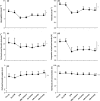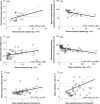Postoperative microcirculatory perfusion and endothelial glycocalyx shedding following cardiac surgery with cardiopulmonary bypass
- PMID: 30687934
- PMCID: PMC6590376
- DOI: 10.1111/anae.14577
Postoperative microcirculatory perfusion and endothelial glycocalyx shedding following cardiac surgery with cardiopulmonary bypass
Abstract
We investigated microcirculatory perfusion disturbances following cardiopulmonary bypass in the early postoperative period and whether the course of these disturbances mirrored restoration of endothelial glycocalyx integrity. We performed sublingual sidestream dark field imaging of the microcirculation during the first three postoperative days in patients who had undergone on-pump coronary artery bypass graft surgery. We calculated the perfused vessel density, proportion of perfused vessels and perfused boundary region. Plasma was obtained to measure heparan sulphate and syndecan-1 levels as glycocalyx shedding markers. We recruited 17 patients; the mean (SD) duration of non-pulsatile cardiopulmonary bypass was 103 (18) min, following which 491 (29) ml autologous blood was transfused through cell salvage. Cardiopulmonary bypass immediately decreased both microcirculatory perfused vessel density; 11 (3) vs. 16 (4) mm.mm-2 , p = 0.052 and the proportion of perfused vessels; 92 (5) vs. 69 (9) %, p < 0.0001. The proportion of perfused vessels did not increase after transfusion of autologous salvaged blood following cardiopulmonary bypass; 72 (7) %, p = 0.19 or during the first three postoperative days; 71 (5) %, p < 0.0001. The perfused boundary region increased after cardiopulmonary bypass; 2.2 (0.3) vs. 1.9 (0.3) μm, p = 0.037 and during the first three postoperative days; 2.4 (0.3) vs. 1.9 (0.3) μm, p = 0.003. Increased plasma heparan sulphate levels were inversely associated with the proportion of perfused vessels during cardiopulmonary bypass; R = -0.49, p = 0.02. Plasma syndecan-1 levels were inversely associated with the proportion of perfused vessels during the entire study period; R = -0.51, p < 0.0001. Our study shows that cardiopulmonary bypass-induced acute microcirculatory perfusion disturbances persist in the first three postoperative days, and are associated with prolonged endothelial glycocalyx shedding. This suggests prolonged impairment and delayed recovery of both microcirculatory perfusion and function after on-pump cardiac surgery.
Keywords: blood oxygen transport, oxygen delivery to tissues: factors impacting; cardiopulmonary bypass management; endothelial glycocalyx; microcirculation.
© 2019 The Authors. Anaesthesia published by John Wiley & Sons Ltd on behalf of Association of Anaesthetists.
Figures





References
-
- Koning NJ, Atasever B, Vonk AB, Boer C. Changes in microcirculatory perfusion and oxygenation during cardiac surgery with or without cardiopulmonary bypass. Journal of Cardiothoracic and Vascular Anesthesia 2014; 28: 1331–40. - PubMed
-
- Koning NJ, Vonk AB, Vink H, Boer C. Side‐by‐Side alterations in glycocalyx thickness and perfused microvascular density during acute microcirculatory alterations in cardiac surgery. Microcirculation 2016; 23: 69–74. - PubMed
-
- Koning NJ, Simon LE, Asfar P, Baufreton C, Boer C. Systemic microvascular shunting through hyperdynamic capillaries after acute physiological disturbances following cardiopulmonary bypass. American Journal of Physiology ‐ Heart and Circulatory Physiology 2014; 307: H967–75. - PubMed
-
- De Backer D, Dubois MJ, Schmartz D, et al. Microcirculatory alterations in cardiac surgery: effects of cardiopulmonary bypass and anesthesia. Annals of Thoracic Surgery 2009; 88: 1396–403. - PubMed
-
- Jongman RM, Zijlstra JG, Kok WF, et al. Off‐pump CABG surgery reduces systemic inflammation compared with on‐pump surgery but does not change systemic endothelial responses: a prospective randomized study. Shock 2014; 42: 121–8. - PubMed
Publication types
MeSH terms
Substances
Grants and funding
LinkOut - more resources
Full Text Sources
Other Literature Sources
Medical
Miscellaneous

